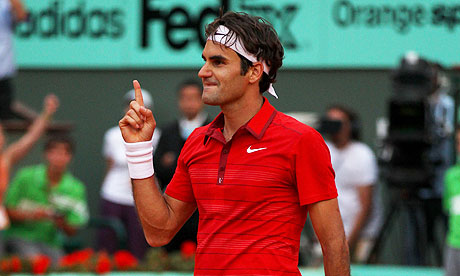A "golden era". Such a nonsensical, hypothetical term that has been ratcheted up and adored by the media who seek to espouse this roll your eyes saying in unhealthy quantities. Recently the term has been bandied around like a grubby, overused handkerchief in Football, F1 racing but predominantly this term has become synonymous with Tennis.
 |
| The Big Four |
Before I embark on my line of argument I must assert my fairly dogmatic and entrenched stance on this hazy, falsifiable topic.
I do not really believe any era to be golden and I do not believe that you can prove indefinitely that one era is golden. For instance strengths in one area, i.e. the dominant top four of today who have won 23 of the past 24 slams dating back to 2008, may mean a relative lack of strength in another, i.e. a weaker chasing pack unable to dismantle the top 4's bastion in tandem with a paucity of precocious youngsters bursting onto the scene as was seen in yesteryear.
In addition is 2013 really a golden era? Federer has dropped to his lowest ranking in a decade, Nadal is very injury prone and Murray and Djokovic suffer from prolonged spates of inconsistency outside slams. What is so golden about that?
In subsequent years gone by, there has also been a very strong pool of players at the summit of the rankings. In the 70's there was Borg, Connors, Newcombe, Rosewall, Vilas and Ashe; In the 80's there was McEnroe, Lendl, Wilander, Edberg and Becker and in the 90's Sampras, Agassi, Courier, Kuerten and Rafter ruled the roost and all boast similar Grand Slam totals to today's total. Can they not be seen as golden?
 |
| Tennis greats! |
If a 39-year-old Jimmy Connors can reach the US Open semi finals or the unseeded duo of Chris Lewis and Malivai Washington reach the final of Wimbledon in 1993 and 1996 respectively does that make that tournament, year or era weak?
Andy Murray, despite modest Grand Slam performances in 2009 (4th round, quarter final, semi final), became world number two merely on the back of strong masters 1000 showings, an injury to Rafael Nadal and a dip in form of Djokovic. Does that also mean this was a weak slam/year/era?
In the 90's the stark difference between the the four Grand Slams resembled a decathlete performing the long jump, the 1500m, the shot put and the pole vault, whereas nowadays the Sahara Arctic contrast is replaced by repeating the same 400m event four times over.
 Unfortunately this surface homogenisation may have led to a skillset homogenisation as serve and volleying, chip charging and low margin attacking tennis is almost defunct and redundant; a stance also held by former Wimbledon champion Pat Cash.
Unfortunately this surface homogenisation may have led to a skillset homogenisation as serve and volleying, chip charging and low margin attacking tennis is almost defunct and redundant; a stance also held by former Wimbledon champion Pat Cash."The guy who outlasts the other one wins. It's taken a lot of the skill out of tennis. Modern players don't dive around the net, deliver backhand smashes, twist and turn like past generations."
Cash, often fond of controversial, against the grain statements, does have a point. The 21st century greats don't have to contend with net rushers or many players with a lot of variety. They play in an era where racket and string technology has advanced to levels where players can hit ridiculous passing shot winners from way outside the court, something beyond the realms of possibility in the 80's and 90's.
Today's dominance is illustrated by Federer, Nadal and Djokovic who have won three of the four slams in a calendar year for five of the previous nine years, compared to a meagre two in the past thirty four years. Evidence of a golden era or conditions greatly favoring those most adept at thriving under the present conditions?
This dependence on ultra fit super human athletes that can play gruelling marathon like matches for 5 hours plus - it is no coincidence that the top four players possess herculean fitness and defensive skills far superior to the rest of the field - is having an adverse effect on the ability for youngsters to make an impact on the game.
Youngsters, who rarely make it into the second week of Grand slams and are quite a way off the top 10, are now deemed "young" if they are between the 20-23 category, whereas in decades gone by Grand Slam Champions were all teenagers: Boris Becker (17), Mats Wilander (17), Bjorn Borg (18), Sampras (19) and Nadal (19).
Mats Wilander, Roger Federer and Andre Agassi's fitness trainer Gil Reyes are "seriously worried" about the worrying dearth of young up and coming tennis talent (no teenagers in the top 200) and "don't see any obvious candidates for a future Grand Slam champion."
 |
| Where are all the youngsters? |
"I think it takes bigger stronger athletes, which is what is out there. But it takes time for them to develop. You have your aberrations: Murray, Del Potro, Rafa etc, but not many." - Federer's former coach Paul Annacone.
Furthermore the prize money at challenger and future level events has stagnated which makes it harder for young players to continue the demanding tennis lifestyle that requires a large support ensemble in order to reach the highest echelons of tennis.
Is this good for the sport's future? This attritional style could increase the likelihood of injury and shorten players careers.
 |
| Court slowdown |
Then again if the current top four did sweep the slams as per usual, THAT would be the true test of their "golden era" credentials, but until that day of variety comes we cannot truly and accurately determine if an era is golden; something the British media in particular won't understand or accept for sure.
